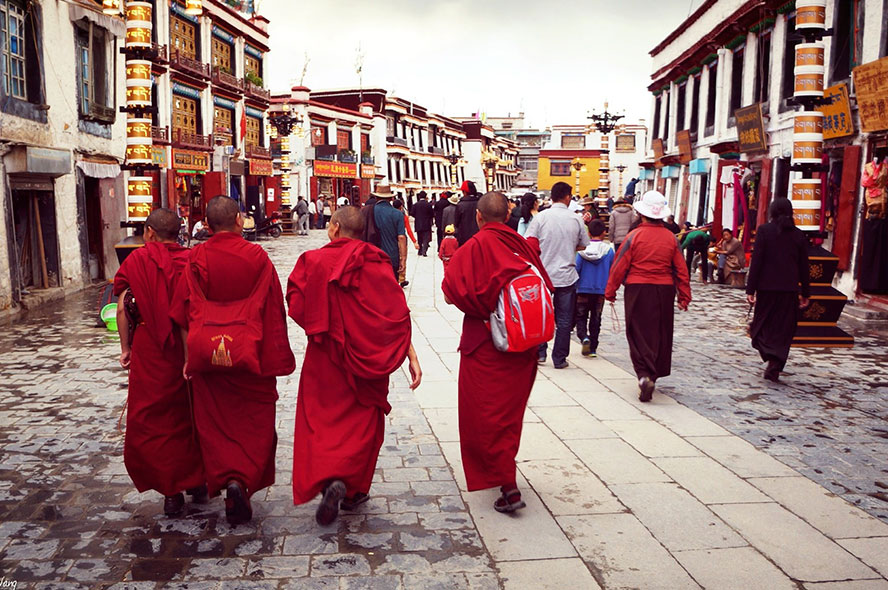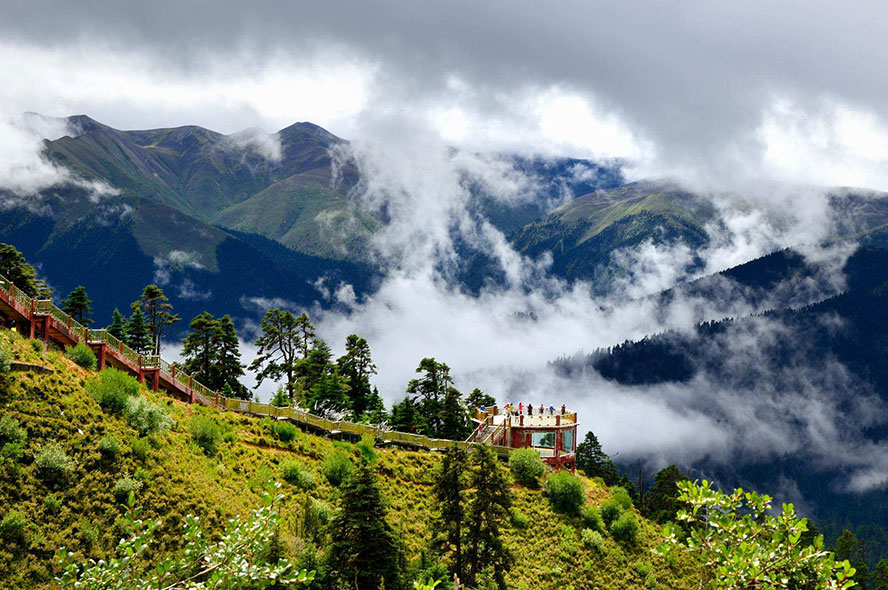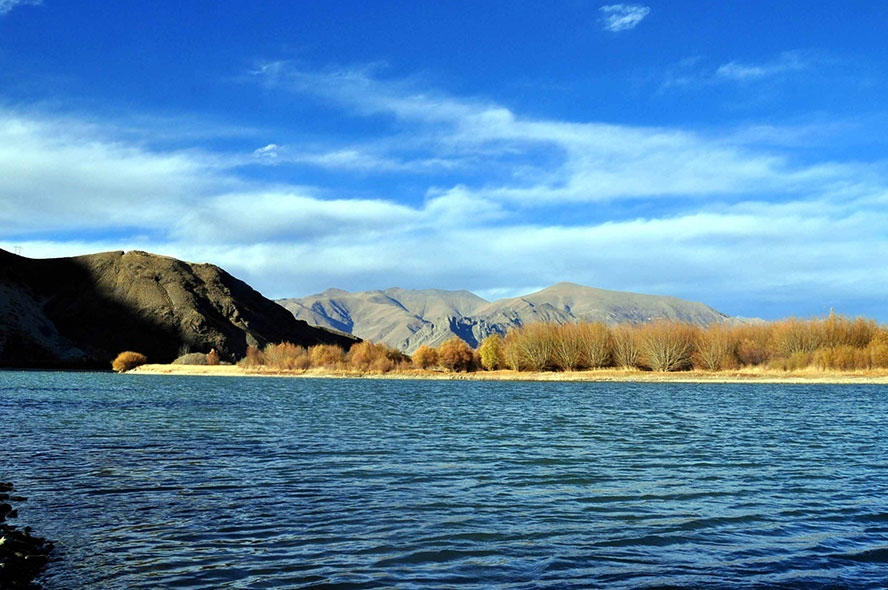Taking trains is not only a mean of transportation to Tibet, but is also a good way to enjoy the scenery in Tibet. When the Qinghai-Tibet trains pass through the Tanggula Railway Station (the highest station along the Qinghai Tibet Railway) and the uninhabited area of Hoh Xil, passengers are able to see wild animals such as Tibetan antelopes from the trains. Will those who have never been to the plateau by taking long-distance trains feel uncomfortable and get altitude sickness? The answer is "Yes". However, that’s not a problem needs to be worried about at all, because oxygen supply facilities are provided on all Qinghai-Tibet trains and passengers can use them when they feel they are lack of oxygen while taking the trains. For more information about the oxygen supply facilities and methods to use them, please read the following passage.
Introduction to the oxygen supply systems on the Qinghai-Tibet trains
Based on the oxygen supply systems on aircraft, two systems of oxygen supply were created for the Qinghai-Tibet trains, so that passengers wouldn’t get serious altitude sickness while the trains are passing through high-altitude areas and they are able to fully enjoy their train journey.
The dispersion-mode oxygen supply system
This is a system which spreads oxygen to the air through the air-conditioning system on the trains. Therefore, it is also called "central air-conditioning oxygen supply system". Oxygen content in the air can be kept at a level of around 23% because of this dispersion-mode oxygen supply system. When the trains are running through the 5,072-meter-high Tanggula Railway Station, oxygen content in the air is the same as it is in the places which are located at an altitude of 3,600 meters.
The distribution-mode oxygen supply system
The other system is the distribution-mode oxygen supply system. When you feel that you need more oxygen or you are uncomfortable, you can inhale oxygen through the independent oxygen outlets, so that you wouldn’t get altitude sickness. For passengers in the hard seat carriages, they can find oxygen outlets under their seats. For passengers in the sleeper carriages, they can find them near their bunks and in the corridor of each hard sleeper carriage. The service is for free. So when you have any difficulties in breathing, please contact the staff as soon as possible. Oxygen content of the distribution-mode oxygen supply system is higher than the dispersion-mode oxygen supply system and is the same as the content in the places of 2,000 meters.
The rolling screen in each carriage will show inside and outside information of the trains,such as real-time altitude, temperature, oxygen content, and railway speeds etc. Therefore, passengers can know all the situation about the trains better.
Introduction to the altitude changes from Xining to Lhasa
The Qinghai-Tibet Railway originally refers to the railway from Xining to Lhasa. Construction of the railway was divided into two sections: the Xining - Gulmud section and Gulmud - Lhasa section. The first section of the railway was completed in 1984, while the second section was not put into operation until 2006 because of many difficulties. The following is the introduction to the altitude changes from Xining to Lhasa. (Travel Routes to Tibet by Trains)
Section 1 - Xining to Golmud
Compared with the whole Qinghai-Tibet Railway, Xining-Golmud section is relatively low in terms of altitude. Therefore, oxygen supply is not needed while the trains are running through Xining - Gulmud section.
The total length from Xining to Golmud is 850 kilometers and the duration is about 6 hours 50 minutes. There is only one station along the Xining - Golmud Railway - the Delhi Station, and average railway speed is 120km/h.
Average altitude of Xining - Golmud section is about 3,000 meters. Even the highest point is only 3,400 meters, and it is located between Qinghai Lake and Delhi.
After the trains set off from Xining, the altitude will increase slowly from 2,300 meters(Xining) to 3,100 meters (Qinghai Lake). When the trains have passed through Delhi, the altitude will decrease because of the Qaidam Basin and the altitude of Golmud is only about 2,800 meters.
Section 2 - Golmud to Nagqu
The Golmud - Naqu section is the highest section of the Qinghai-Tibet Railway. When the trains arrive in Golmud, a more powerful locomotive will be replaced on the trains to generate and supply oxygen. And after leaving Golmud, the trains begin to supply oxygen for passengers.
The total length from Golmud to Naqu is 850 kilometers and the duration is about 10 hours, which is 3 hours longer than the first section. Because of the high altitude and wildlife refuges along the way, average railway speed is slower - 80km/h.
Average altitude of Golmud - Naqu section is about 4,500 meters. The highest station along the way is the Tanggula Railway Station - about 5,100 meters.
Within an hour after the trains leave Golmud, the altitude will increase from 2,800 meters (Golmud) to 3,500 meters. When the trains keep running for another hour, the altitude will increase to over 4,000 meters.
The altitudes of Kunlun Mountain Pass and Tanggula Mountains are 4,767 meters and 5,072 meters respectively. Between the two places are the famous Hoh Xil area and the inhabited area of Tibetan antelopes. Therefore, when you want to see incredible sightseeing, you need to stand on places of high altitude.
Section 3 - Naqu to Lhasa
Naqu is the first station located in Tibet. When the trains arrive in Naqu, there is only 4 hours left to for the train ride to Lhasa.
The total length from Naqu to Lhasa is 320 kilometers and the duration is about 4 hours. Since the trains are running on plateau ares, average railway speed is the same as it was in the previous section ( 80km/h) in spite of the decrease of average altitude (4,000 meters).
The highest point (4,600 meters) of this section is located within the Nyenchen Tanglha Mountains and the lowest point is Lhasa - 3,600 meters.
The altitude of places within Qinghai Province is relatively low. After the trains pass through Golmud, the altitude increases slowly and the trains begin to supply oxygen for passengers. The highest point of the railway is the Tanggula Railway Station, from which the altitude will keep decreasing all the way to Lhasa.
Altitude sickness on the trains
Symptoms of altitude sickness while taking the trains
Altitude sickness refers to all kinds of pathological symptoms that occur when a person is rapidly exposed to low-pressure and low-oxygen environment. It is common on plateau areas. General symptoms of altitude sickness include headache, trouble sleeping, loss of appetite, tiredness, and difficulties in breathing, etc. Headaches are the most common symptom. People will often feel a pain in their foreheads or temples and the pains will get worse at nights or in the morning. To relieve the headaches, passengers can do activities such as mouth breathing and light activities.
Besides, if you have the followings symptoms, you might be suffering altitude sickness.
1. Dizziness, nausea and vomiting, shortness of breath, chest tightness and chest pain, insomnia, somnolence (a very sleepy state), loss of appetite, abdominal distension, numbness of hands and feet.
2. When you are taking a rest, you only have mild symptoms of palpitation, shortness of breath, chest tightness and chest pain, etc. But the symptoms are particularly prominent after you do activities.
3. Significantly faster pulse, light or moderate blood pressure elevation (or reduction), cyanosis in lips and fingers, and eyelids or face oedema.
How to prevent altitude sickness when oxygen supply is available on the trains
Even though the Qinghai-Tibet trains are equipped with advanced oxygen supply facilities, still a small amount of tourists may get mild or serious altitude sickness. This is not because the oxygen supply on the train is ineffective, but is because that each person’s ability of adapting to external changes is not the same.
1. Most people who go to plateau areas for the first time will get light or serious altitude sickness. And there is no answer to the question of “What are the commons of those who are more likely to get altitude sickness?” Many of the symptoms are caused by psychological effects, so the best way to avoid or reduce altitude sickness is to maintain a good mood and face it bravely. We recommend that passengers take more rest on the trains, don’t do too much exercise, and avoid violent mood swings.
2. The aisles on the trains are relatively narrow, so passengers shouldn’t walk too fast or run on the trains. When the trains pass through high-altitude areas, passengers should sit on theirs seats to take a good rest and shouldn’t move around. Therefore, the trains pass through the Tanggula Mountains area usually during night, so that passengers can have a good rest to relieve altitude sickness, and oxygen can also be consumed less. Staying up late to play mobile phones or tablets and read books is not suggested while taking the trains, so when evening comes, passengers are suggested to take a rest as early as possible, because a full rest is very helpful for adapting to the plateau environment.
3. Hot water is provided on the trains. Drinking plenty of water can be very helpful for relieving your stress both psychologically and physically, and you will feel warmer after drinking hot water. The weather on the plateau is mostly dry, so drinking water will be more beneficial to your body and skin. When yu feel your body and mind are comfortable, you are less likely to get altitude sickness. Although there are air conditioners on the trains, you should put on more or take off clothes according to the environment in case you should catch a cold, which is not helpful for relieving altitude sickness at all. On the contrary, a cold will sometimes worsen altitude sickness and make you feel more tired and uncomfortable.
4. You can take some medicines to prevent or relieve altitude sickness, such as Gaoyuan’an (take it at least 1 - 2 days in advance of your journey and keep taking it for 3 - 5 days after you arrive in Tibet), American ginseng lozenges (fatigue relief), Nuodikang capsules (headache relief), Quick-Acting Heart Reliever, Danshen tablets (for cardiovascular disease), and glucose solution, etc. For people who have good adaptability, the symptoms of altitude disease can be eliminated within 1-3 days, and for those whose adaptability is poor, 3-7 days. Please take the medicines by following the instructions of doctors or the package inserts.
More questions about oxygen supply on the trains and altitude sickness
1. Can passengers carry oxygen tanks on the trains?
Although portable oxygen tanks can be helpful when passengers get altitude sickness while taking the trains, oxygen tanks still cannot be carried on the trains because they are flammable and explosive, and they cannot pass through the security check.
If you want to use them after you arrive in Tibet, you can buy them from local shops, and we will also provide free oxygen tanks for our customers. Therefore, you don't have to worry about the oxygen tanks when you are in Tibet. If you want to use them on the trains, the oxygen supply on the trains are better than a portable oxygen tank, so you don't have to worry about the altitude sickness on the trains, either.
2. It there any doctor on the trains?
The altitude sickness is not a disease. Just like those who sit on vehicles which are running on sinuous mountain roads will get carsickness and those who ride roller coasters will vomit, people who can’t adapt to altitude changes will get altitude sickness. It is just a natural physical reaction of the body to environmental changes. The only difference is that people with good adaptability will get light altitude sickness and people with poor adaptability will get serious altitude sickness. It is proved through the experience in the pass over ten years that altitude sickness is not so serious that needs to be checked by a doctor. Therefore, trains to Tibet are now not equipped with doctors or nurses.
3. Are medicines for altitude sickness relief sold on the trains?
Medicines are not ordinary goods, and they can’t be sold everywhere. Therefore, medicines for altitude sickness relief are not sold on the trains. If you feel that you need to take medicines on the trains, you can buy them from drugstores before boarding the trains. If you didn’t buy them and you feel uncomfortable while taking the trains, you can ask the passengers in the same carriage for some medicines. There should be passengers who have prepared medicines for their journey. When you get the medicines, you must follow the instructions of the package insert.
4. Can passengers take sleeping pills to solve sleeping problems while taking the trains?
Insomnia is a problem that have troubled many passengers. Some may think that this problem can be solved by sleeping pills. However, we don’t suggest tourists do that. On the one hand, sleeping pills are originally a kind of medicine, so they should not be taken casually. On the other hand, most tourists choose to go to Tibet by trains is because they want to enjoy the beautiful scenery along the way. If they take sleeping pills in the evening, they would keep sleeping and wouldn't awake the next morning. In this way, they would miss much incredible scenery. Passengers should try to fall asleep in the evening when the trains are running through low-altitude areas in case they couldn’t fall asleep in high-altitude areas. Information about altitudes can be seen from the scrolling screen in the front of each carriage.
No need to worry
Even though the Xining-Lhasa Railway is located at high-altitude area, there are two oxygen supply systems on the trains providing oxygen for passengers, so the oxygen content in the trains is much higher than that outside the trains. Therefore, passengers can take the trains without any worries and can fully enjoy the beautiful scenery all along the way. Even if you get altitude sickness while taking the trains, medical measures are available to help you relieve the symptoms of discomfort.








































 Data in submission...
Data in submission...